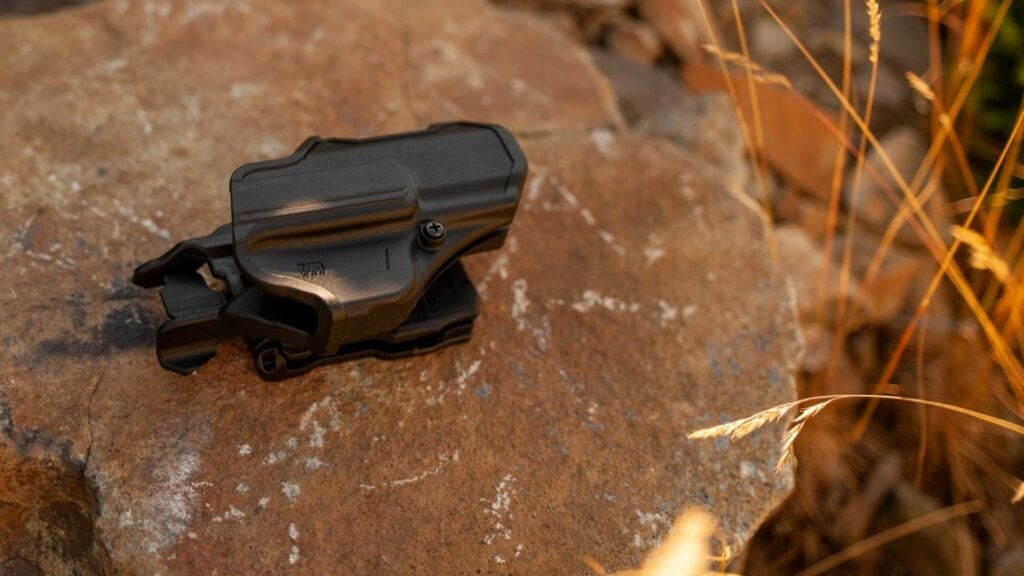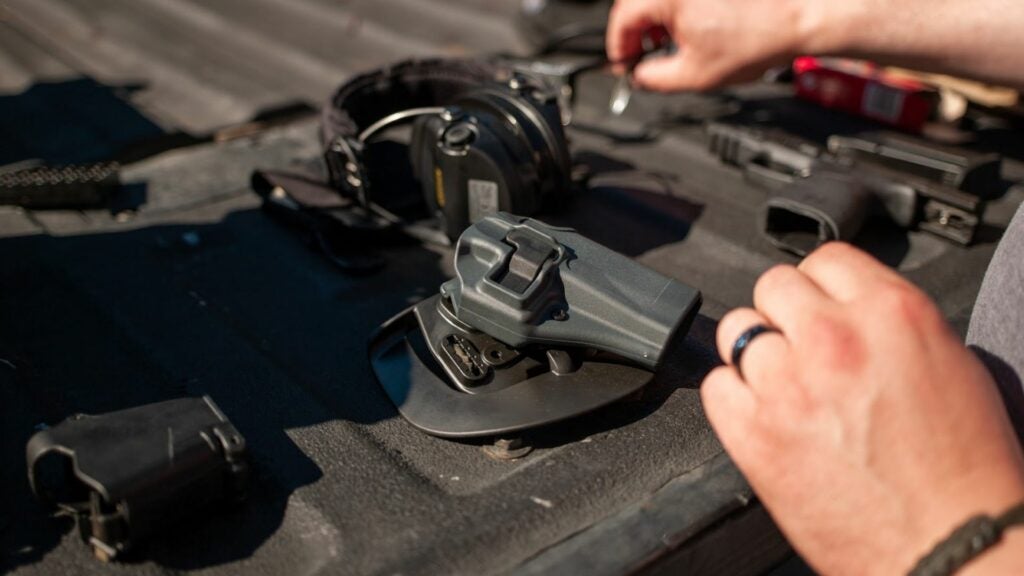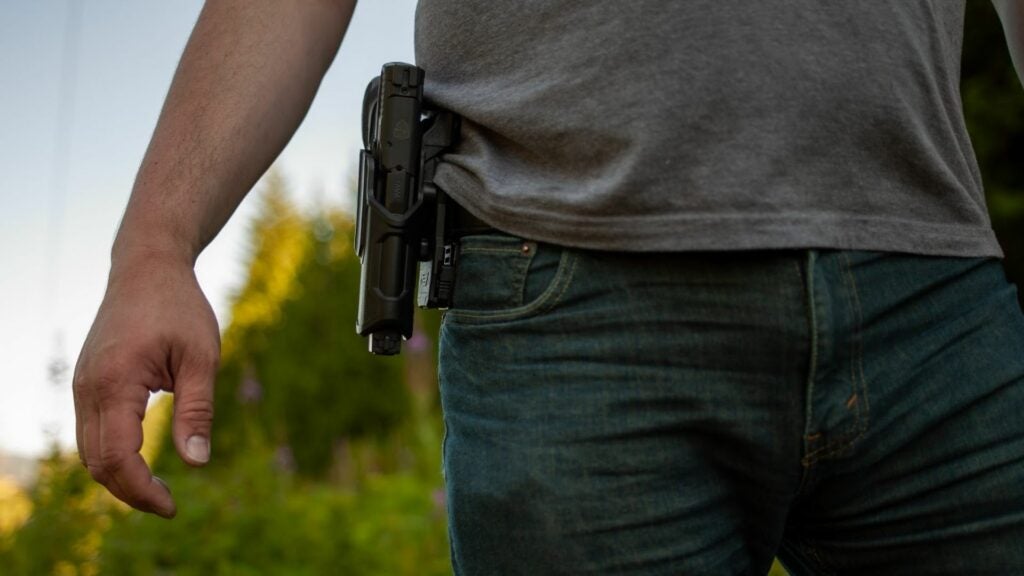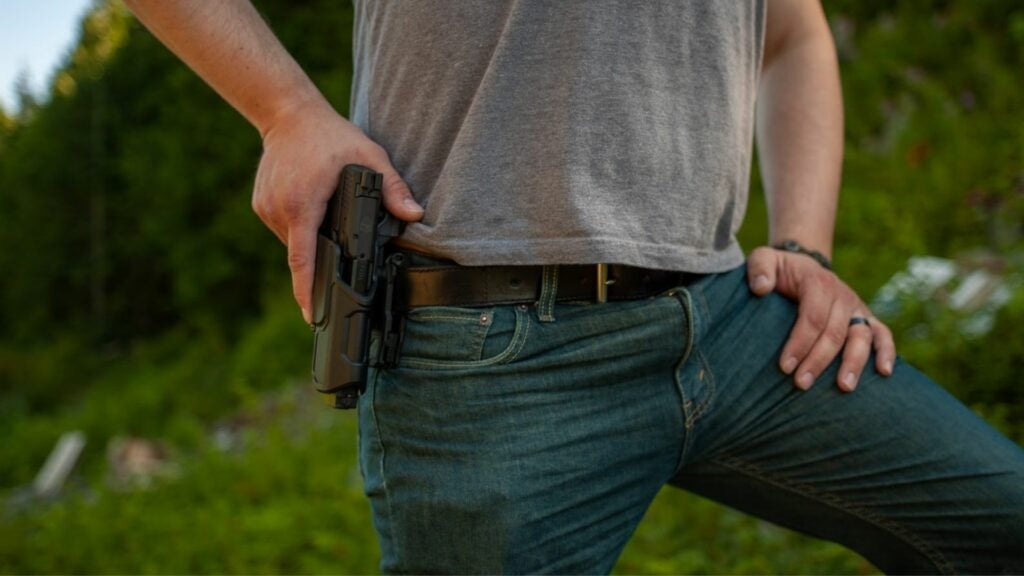I love gun gear. I was an armorer for a good chunk of my Air Force career and worked extensively on the M9 and M4 platforms. As a veteran, I have neither of those; if I ever touch an all-black Beretta 92FS ever again, it’ll be too soon.
My current arsenal is a beautiful .308, a stack of European handguns, a P80, an MKIV 22/45 Lite, and the always-popular M&P 2.0 full-size in 9mm. The M&P is going to be important because I have an old Blackhawk Serpa sportster for it, and Blackhawk has a new update called the T-Series to get around some of the controversies over the Serpa.
If you’ve been issued an M9 during the Global War on Terror, chances are good that you’ve run into the Serpa holster. Blackhawk introduced the Serpa in 2006 as a retention holster for duty weapons, and the Pentagon saw a new toy and started issuing them as a major upgrade to the old Bianchi M12, a turd of a holster. Apparently, Uncle Sam’s Misguided Children still get them today; I think they pride themselves on learning things the hard way. Civilian law enforcement jumped on that train as well, and by 2011, just five years after the Serpa hit the shelves, they were everywhere.
Then, all of a sudden, the Serpa started getting banned by ranges, competition RSOs, and even police departments. It turns out that the FBI did a study of the Serpa’s retention system after a series of four negligent discharges during training between 2010 and 2011, including one with a new recruit. All four NDs resulted in injuries. The LAPD banned Serpa holsters for their officers shortly after. The controversy comes down to which camp you land in. If you believe that training and good mechanics require constant practice, you might not care so much about the Serpa’s release mechanism but you might still worry about retention drills or plastic mounting tabs. If you think spoons make you fat, then you’ll blame the holster for the NDs and blab about “design flaws” for the next 40 minutes while my eyes glaze over and I subtly but desperately search for my next glass of bourbon. (I still like my original Serpa CQC, but fellow gun-nerd and Task & Purpose writer Travis Pike thinks I’m nuts. Check out his recent piece on the Serpa here.)

Part of the issue with the Serpa is that you unlock your handgun of choice using your trigger finger and that some people put their booger hook on the bang switch during the draw process. If that person is on their sixth cup of coffee and has a mean old instructor screaming at them, well, when they mess up the draw, there’s a chance that they hit the bang switch and now there’s a hole in their leg. Or that crusty instructor’s leg, but it seems like he had it coming. I’ve never run into that problem though, or really any others, and I’ve been rolling around with the Serpa CQC for about five years now. I actually have two of them because I really like them despite their well-known flaws.
The old Serpa has a couple of other flaws that the T-Series aims to fix. First, the mounting system is three machine screws threaded into inserts sunk into GFRP (plastic with some fiberglass in it). If you snag the holster on something solid, it’s going to rip off the mounts and clatter to the ground (or if someone tries to take it from you). Second, the retention mechanism can lock up if it gets crud behind it. If you’re rolling around in the sand, mud, or clay, and the holster doesn’t break off, then you get to face challenge number two. You’re done rolling, you got enough of a break in the action to go for your sidearm, and you pull. Nothing happens except the wedgie you just gave yourself yanking on a locked-up holster connected to your pants. Not ideal.
With all that in mind, let’s see how well the Blackhawk T-Series L2C holster succeeds where the Serpa failed as a moderately-priced retention system.
Unboxing
I’ve been a fan of Blackhawk for a while. I unironically love their stuff. I was issued one of their backpacks in 2005 or so and it travelled the world with me as a bug out bag for nearly a decade. I finally broke something on it two or so years ago, when I loaded it down with grad school books and jumped on my motorcycle. I snapped one of the buckles on it. I know there’s a lifetime warranty on the backpack, but I haven’t been able to send it back for repair. Damn thing is way too useful to not have it for a couple of weeks. Besides, who wants to pay $30 in shipping to have a $.50 buckle replaced? I tied it up and it’s been good since. They make great stuff and they stand behind it. I’ve also had their Sportster range bag for four years or so. It didn’t look brand new when I swapped to my GPS Tactical range backpack, but it’s still in great condition and it’s held up great. The holsters are no different, and I really like my Serpa despite the negative press. I was really excited to play with the update they’ve coined the “T-Series.”

Opening the all-black T-Series box, I found a couple of manuals, the holster, and an alternate belt loop mount. The first thing I noticed was the new mounting system. It’s quick release and arguably as good as their previous paddle.
I know you want to roast me in the comments for liking the old CQC’s paddle, but keep in mind that it’s not designed for the Corps. Or even mall ninjas. It’s simply a fast, convenient way to mount a holster for quick concealment, like when your PTSD is making it tough for you to sleep and you just have to walk the dog at 3:00 a.m. to clear your head. The paddle did exactly what I needed it to do, which is to go on my waist easily while being harder for someone else to take it off of me.

The new system doesn’t come with a paddle at all, instead forcing you to wear a belt to make use of the new attachment scheme. It won’t work for the “I buy pants that fit” crowd. For me, and most users of the T-Series, it’s putting the holster on quickly that matters. Taking it off can be a more relaxed affair. I wear a Hank’s gun belt (Kydex lined!) if I’m not at work or in gym attire, so it’s not a big deal for me to rely on it for holster attachment.
The belt attachment is ingenious, with little ramps that help the holster slide down and lock onto the belt but prevent it from coming off easily. The old paddle did something similar with a hook that grabbed under the waistband. Half the time I had to unbutton my jeans to get the paddle out. The new belt mount is adjustable with three positions, the smallest of which is 1.5 inches and fits my Hank’s belt perfectly. There are also slots for 1.75 and 2 inches respectively if you like wider belts. The limit for IDPA is 1.75 inches, in case you were wondering. The quick-release is two button-activated locking tabs, but you’re not super likely to take the holster off quickly or easily because of those ramps. It takes some fiddling and belt-loosening to make it happen.
The proportions are different between the old Serpa and the T-Series. The T-Series has a bit more slide protection and is sculpted with rounded edges and bevels. The tension screw is in the same spot, but there’s a subtle curve to the surrounding webbing now. Blackhawk’s redesign has a couple of other tricks to it. A major difference is the thickness of the GFRP used throughout the holster. The T-Series’ structure is nearly twice as thick as the old Serpa, and is much more sturdy. All of this comes at a cost, and that cost is size: It’s noticeably larger in every dimension. Part of the size difference is in the bosses used to retain the thread inserts. They’re huge and have webbed reinforcement for extra security. It seems like Blackhawk took the criticism of the Serpa seriously and reworked their attachment system for more strength.

The last immediate trick is one of the better innovations from Blackhawk. The interior of the T-Series holster is overmolded in a smooth, slippery, and softer plastic. The M&P 2.0 slid in and out like it was buttered by a Wisconsin milkmaid. The older model scraped and clattered in. It wasn’t something I noticed or cared about while carrying the old Serpa around, but now that the T-Series is so slick, I can’t go back.
How we tested the Blackhawk T-Series L2C holster
As with any gear related to firearms, there are strictly defined limits to what you can and can’t do in public. I didn’t practice quick draws in the park or get into any road rage situations on the motorcycle so I could wave a pistol around. I took the T-Series holster to the range and practiced drawing in a private booth, doing it side-by-side with my old Serpa. I did strong side only draws knowing that if I have to draw for real, I’ll have a leash in my left hand and 60 pounds of muscle and teeth (a boxer mix named Athena) pulling on my weak side.
I carried on my late night dog walks to get a feel for how fast I can get the holster on and how much of a pain it is to take off when I get home. It took a couple of weeks before I got to the quick draw stage, but I finally managed to get out of town and brought the holster along to my spot up in the mountains. The T-Series was definitely a slower draw than the Serpa.

What we like about the Blackhawk T-Series L2C holster
I have a love/hate thing going with the belt mount. The mount itself is secure and I really like the ramps and adjustability for different belt widths.
The T-Series has a really nice positive lock just like the old Serpa did, and the toggle itself is well-protected. You’re not going to have an accidental toggle or any problems with retention. As far as the thumb release goes, it’s pretty good. The design sort of reverses the locking mechanism of the Serpa and solves the problem of the old one getting locked out in mud. The area behind the lock is open and there’s nothing for the hinge to lock against. If it does lock up, it locks in the open position so you can still get to your pistol.

I also like how the grip is in the same spot as the old version — that’s also going to be a problem for some people as I explain below. The other improvements were welcome but increased the size of the holster overall. The T-Series feels much sturdier than the Serpa, and should, considering the extra material and webbing molded in. Blackhawk really listened to the community and redesigned their retention holsters based on that feedback. The webbed boxes for the screw inserts were a neat touch. There’s also some new detailing and design work with beveled angles, a logo, and a stamp showing off that the new holsters are made in Montana. I love that. I also love the new overmolded liner that slides way more smoothly and quietly than the Serpa. That was a great idea.
What we don’t like about the Blackhawk T-Series L2C holster
While I genuinely like the new mounting system, it has two big flaws for me. First, I’m forced to wear a belt to carry this holster. It’s not a dealbreaker or anything, but I like the way the paddle works and how it’s belt-agnostic. Second, due to the built-in thumb toggle protectors, the last bit of cant adjustment isn’t available. With the paddle, I could adjust the Serpa CQC exactly how I liked it. The T-Series just misses that mark and can’t use the last screw hole. You’re limited a bit more in the cant angle because of that physical interference, and I found that slightly disappointing.
The T-Series has a smaller flaw related to the belt mount in that it rides around an inch higher compared to the CQC’s paddle. It’s better for concealment but feels off to me anyway. I really liked where the CQC placed the butt of my pistol. The T-Series is generally bigger in every direction which adds to the issue.
My other gripes are relatively minor but might tick off others or be deal breakers on the safety front. I’m disappointed that the T-Series is so limited in fit. I’m sure more and more pistols will be added to the list, but right now, out of my arsenal, only the M&P 2.0 has a T-Series holster available at all. We still don’t know if the Glock full-size model will fit the P80, and I haven’t seen one at my LGS to even try. The T-Series doesn’t come in VP40, or really anything outside of Glocks and a Sig or two, and most of the time they’re sold out. This review probably won’t help that situation because I genuinely like the holster and you will too.
I think the last gripe will be the most controversial. The Master Grip Principle that Blackhawk touts is still an issue with the new design. There will always be some concern over negligent discharges because your trigger finger winds up in the same place during the draw as with the old Serpa design. The only difference is that you’re now using your thumb to release so that your trigger finger remains straight. I don’t think that’s much of a safety improvement if that’s your concern with the Serpa. I found it to be a step backward because, with the Serpa, your thumb was already wrapped and in the right place during the draw. My hand position on the Serpa was better and I was using the only finger that should move at all when handling pistols. Using my thumb wasn’t a huge change, but I found that drawing was quite a bit slower with the T-Series than with the Serpa.

Verdict
I like the T-Series. It’s a good value for a retention holster, and the important stuff is all there. It’s lightweight, sturdy, easy to grab and go, and it’s secure. It’s a great holster.
If you already have a Serpa and you like it, I’m not sure it’s worth the upgrade. It might not be available if you have something even slightly out of the norm, like my VP40. H&K isn’t a newcomer to handguns, and neither is CZ. I have a P-01 on the way and I won’t be able to get this holster for it either. Good luck if you’re rocking a Canik or any of the other new designs hitting the market.
If you’re looking for a retention holster for your Glock and you don’t need it for duty, it’s hard to beat the T-Series. I’ll be buying one for my P80 (if I can get my hands on one), and when it comes to the VP40, I’ll upgrade if/when the T-Series becomes available for it.
If you don’t have a carry holster for your handgun, and you’re looking for active retention, you’ll be happy with the Blackhawk T-Series. Best of luck finding one!
FAQs about the Blackhawk T-Series L2C holster
More questions? Here’s Task & Purpose’s additional brief.
Q. How much does the Blackhawk T-Series L2C holster cost?
A. At the time of writing, the L2C is around $50 on Amazon.
Q. Are Blackhawk holsters safe?
A. You’re going to find a lot of stories on both sides of that question, but the T-Series gets rid of a lot of the problems some people had with the older Serpa model. All guns and gun products should be treated with a healthy amount of respect, and these holsters are no different. They’re as safe or as dangerous as you make them. I don’t believe the T-Series is inherently dangerous.
Q. Where are Blackhawk T-Series holsters made?
A. The T-Series is manufactured at Blackhawk’s plant just outside of Bozeman, Montana.
We’re here to be expert operators in everything How-To related. Use us, compliment us, tell us we’ve gone full FUBAR. Comment below and let’s talk! You can also shout at us on Twitter or Instagram.
Drew Shapiro served two enlistments in the Air Force riding around on C-17s. Thanks to the GI Bill, he now rides a desk in the Pacific Northwest. When he’s not wearing a suit, Drew’s usually out getting his hands dirty. He tests gadgets the hard way so you don’t have to.
Task & Purpose and its partners may earn a commission if you purchase a product through one of our links. Learn more about our product review process.
